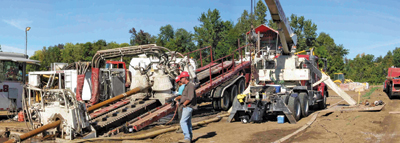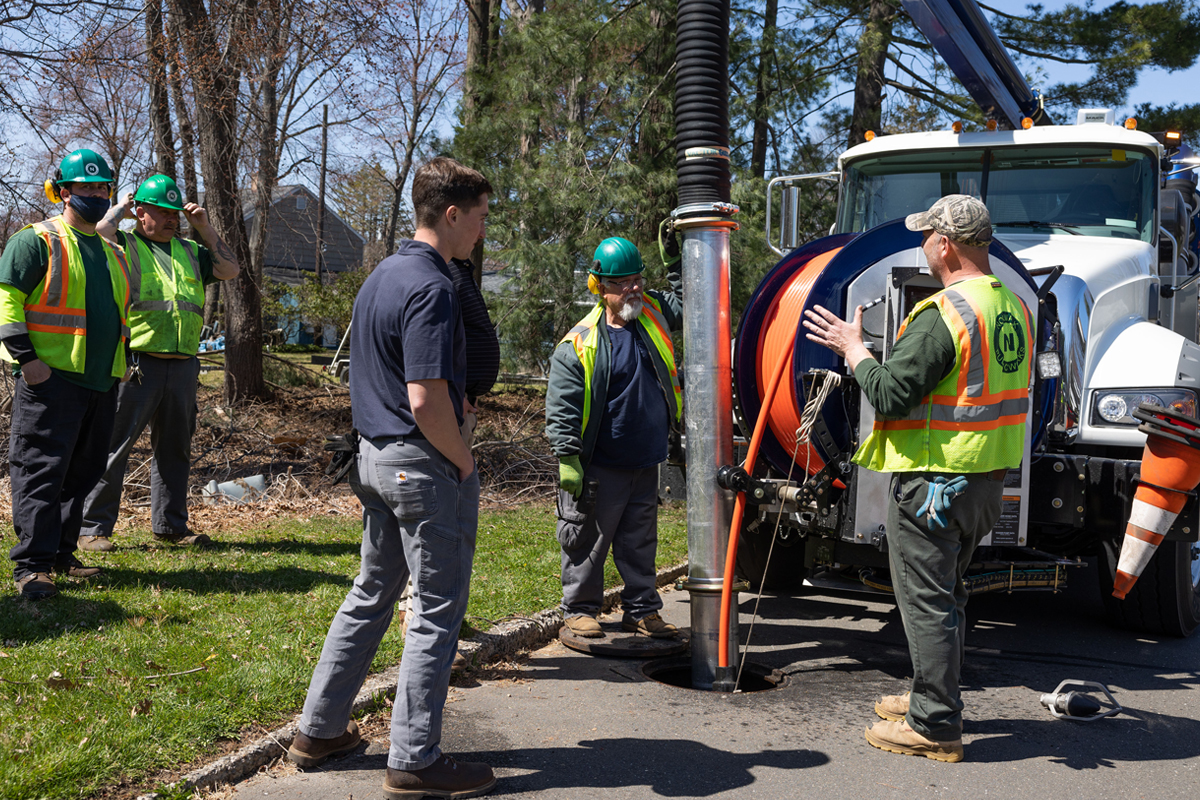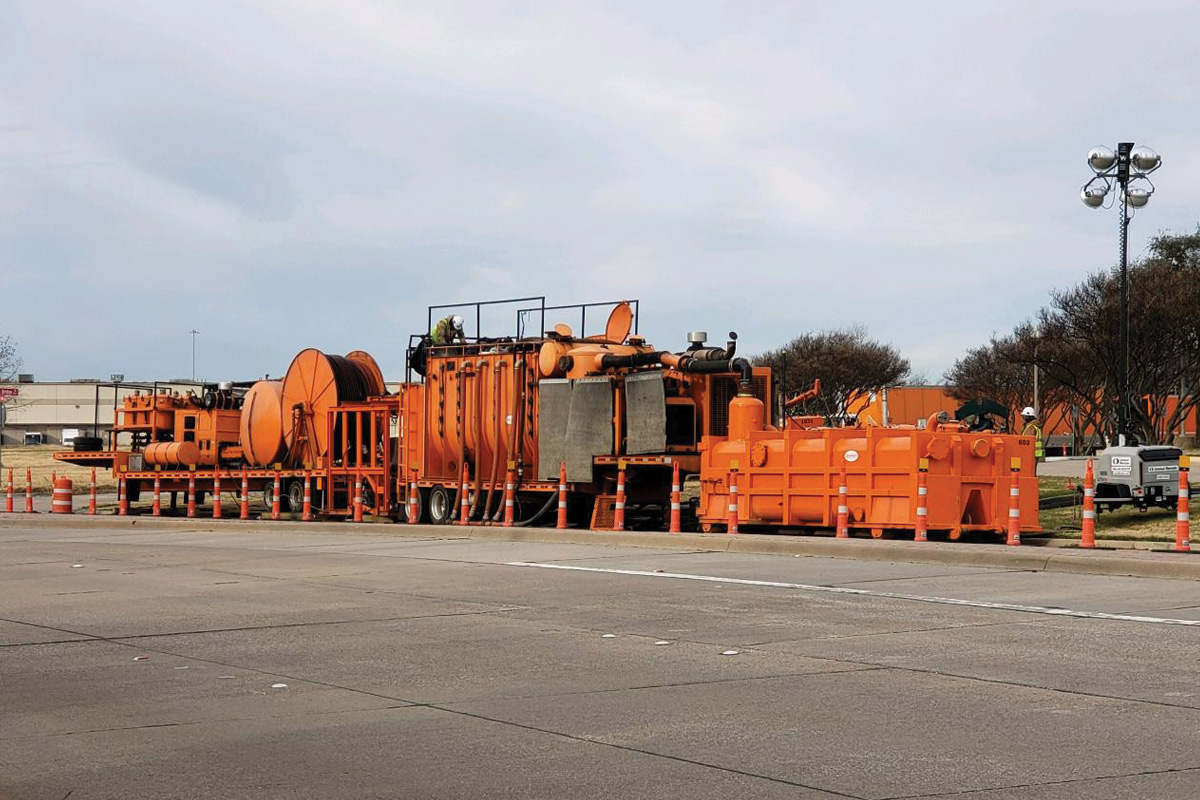Chemical Treatment of Horizontal Remediation Wells
April 19, 2012
 The remediation of horizontal wells presents a different set of problems as opposed to vertical wells. Horizontal wells installed in the vadose zone, (above water table) as opposed to the saturated zone, (below water table) often require different treatments and processes.
The remediation of horizontal wells presents a different set of problems as opposed to vertical wells. Horizontal wells installed in the vadose zone, (above water table) as opposed to the saturated zone, (below water table) often require different treatments and processes. Wells can be treated with any number of chemicals, but such treatments do not necessarily benefit the well or increase productive capacity. It is therefore important, when considering a stimulation or rehabilitation program, to correctly identify the reasons for the decreased well yield.
First, let’s examine the factors surrounding decreased well yield. Low horizontal well yields may result from many factors. The proper well material (steel, HDPE, PVC, and stainless steel) may not have been used during original well construction or, in older wells, considerable corrosion of the well screen and/or casing may have occurred, especially with fluctuating water tables. Contaminants may not be compatible with the well material. Caution should be exercised in selecting the proper material. The well screen construction itself (slot size and placement, geo-fabric, retaining screens, etc.) may not be right for the desired application or installation procedures. Pumping velocities during pilot drilling or pull back may have been excessive, or a poor pre-pack construction may be allowing passage of excessive amounts of silt and clay. The reasons for such problems cannot always be corrected with chemicals, although the results may be correctable on a short-term basis.
Commonly, the initial yield of a well may decrease because of movement of the well screen or casing, or because of incrustations of calcium carbonates, iron manganese hydroxides/hydrated oxides, bacterial slimes, or because of simple silt and clay plugging. Most, if not all, problems can be successfully alleviated by chemical treatments.
The most effective way to open up the perforations and the formation pore spaces to increase the flow is to include the use of a properly designed chemical treatment. These treatments are placed while jetting the screen, allowing time for the chemicals to work, and then use a combination of swab, surge and pump out to remove the debris.
There are several requirements that any chemical should meet if it is to be used for treating horizontal remediation wells. First, it must meet any stringent regulatory requirements for the specific site, and it must be compatible with the potential contaminant to be encountered. It should be effective in dissolving, disintegrating and dispersing commercial drilling muds (including polymers), clays, and shales so that they can be easily removed or pumped out. It should be capable of dissolving limestone and water deposited scales, corrosion products and organic growths. Additionally, it should be relatively non-toxic and should not contaminate the formation. It should also be safe to use on the mechanical equipment in the well, be safe and easy to handle.
Before any chemical treatment is considered, it is necessary to admit or establish the fact that some pore spaces have been plugged off and that a chemical treatment is the easiest and most effective method of removing any plugging.
The following illustration attempts to represent some of the things that may happen when a horizontal well is drilled. These things will occur whether the drilling is by rotary or jetting method. Note that most horizontal environmental wells are much shallower. Most are less than 30 ft below ground level.
In order to drill, a fluid is circulated to remove the cuttings and maintain the integrity of the well bore. In most all cases, drilling mud is used. It can be commercial drilling mud (gel or polymer), and as it happens there’s enough clay in the formation to make the mud heavier as drilling progresses. As the formation is penetrated, a mud or filter cake is built up on the walls of the hole. The mud cake must be strong enough to hold the pressure of the column of mud in the hole; otherwise you will lose circulation and all the mud will go back into the formation. If the mud is too thin or is a polymer, the mud cake will build up too far back in the formation and will be more difficult to remove.
After the well is drilled it is necessary to remove all the mud cake if the horizontal well is to be developed to its maximum capacity. Using the illustration you will note that at the static water level of 200 ft the mud was put in place under 125 psi pressure and at 300 ft it was 188 psi. Now after all the mud has been removed from the hole by pumping or swabbing, the only pressure available to push the mud off the wall and out of the formation is the pressure of the water in the formation. At the static water level of 200 ft there is no pressure. There could be several clay or shale breaks, which reduce the total pressure. Of course, the horizontal well installed in the vadose zone, has no pressure at all available to push the drilling fluids back to the well bore for subsequent removal.
So the following condition exists: mud put in place under 125 psi at the static water level and no water pressure to remove it, and at 300 ft mud put in the formation at 188 psi and at most, only 42 psi water pressure to push it out. Naturally, the deeper (true vertical depth) and longer (measured depth–or-length) the hole and the less standing water there is, the greater the differential pressure (400 psi opposed by 42 psi) at the end of the well.
With a jetting or mud motor horizontal drilling assembly, the pressure is applied all along the horizontal well bore, which is usually the screened section. As the well bore is advanced, increasing fluid pressures are required to move the mud to the surface, thus increasing the invasion of the mud into the formation.
Additionally, the rotation or movement of the drill rods on the bottom of the well bore causes force to be exerted at right angles to the well path, along the bottom of the bore. As a result, as the drilling progresses, the formation around the well bore is compacted and the mud and slush in the hole is pounded back into the formation. The effect of this plugging and compaction is naturally a lower specific capacity.
In a sand and gravel well, a mud cake builds up on the walls and the formation and compacts around the well bore. Since this is behind the casing or screen and behind the sometimes obtrusive well screen (shumasoil, geo-fabric, Pre-Pac, etc.), purely mechanical means will not be effective in removing it. In order to get maximum capacity all of the mud must be removed and the formation opened up to allow free flow of water or air to (injection and sparge) or from (recovery and vapor extraction) the formation and the well bore.
Silts and Clay Buildups
Older wells frequently experience yield or efficiency declines due to the buildup of silt and clay in the aquifer near the well, in the wells gravel pack, or against the well screen or geo-filter/membrane. Newly drilled wells may not yield expected amounts of water, or efficiency due to “mud cake” partially sealing the aquifer or pore space immediately surrounding the well screen. This results in the acids dissolving cations present in the clay, thereby allowing precipitation of free silicon dioxide (SiO2) as a gel. A liquid polymer dispersant additive will not only dissolve the “mud cake”, but it will also act as a strong sequestering agent, which prevents precipitation or flocculation of the silt and clay particles. There are effective treatments available today to address these situations, including AQUA-CLEAR PFD Polymer Dispersant from Baroid IDP.
Carbonate Scales
Probably more horizontal environmental wells experience decreased yields and efficiency due to incrustations of calcium carbonate (CaCO3) or calcium magnesium carbonate (CaMg (CO3) 2) than from any other type of incrustation. Carbonate scales form mainly in horizontal wells installed in hard water aquifers. There are products on the market today that can tackle carbonate scales, AQUA-CLEAR MGA Modified Granular Acid is formulated to address this.
Iron and Manganese Scales
Iron scale, iron bacteria, sulfate-reducing bacteria, manganese hydroxide and manganese carbonate scales are all soluble in acids. The use of a dry acid special additive was previously described. An acid enhancer/antifoulant is a potent combination of acids with a nonionic surfactant, which promotes emulsions. These can also act as a chelating agent for a number of metals. This simply means that the acid exhibits complexing ability for iron in its anionic form, thus increasing the iron solubility. Baroid IDP’s AQUA-CLEAR AE is one product on the market that focuses on these scales.
Summary
The problem is not how or why the formation or screen is plugged off but how best to remove the plugging so that maximum flow can be obtained. Fortunately, swabbing, surging, back washing (jetting) or pumping will remove much of the plugging.
Chemicals can effectively remove practically any type of accumulation from horizontal wells. Instead of spending a lot of time trying to completely remove all plugging by mechanical methods, a properly designed chemical treatment will make it possible to do the job better and in less time. Many times one section may be over developed in order to adequately develop another section. By chemically treating along with the usual mechanical methods all sections can be developed uniformly.
The big advantage with chemicals is the fact that they can penetrate through the screen or perforations and back into the formation where there is little if any agitation from the mechanical methods.
John H. Berry, P.G.,is a senior account representative with Baroid IDP.




